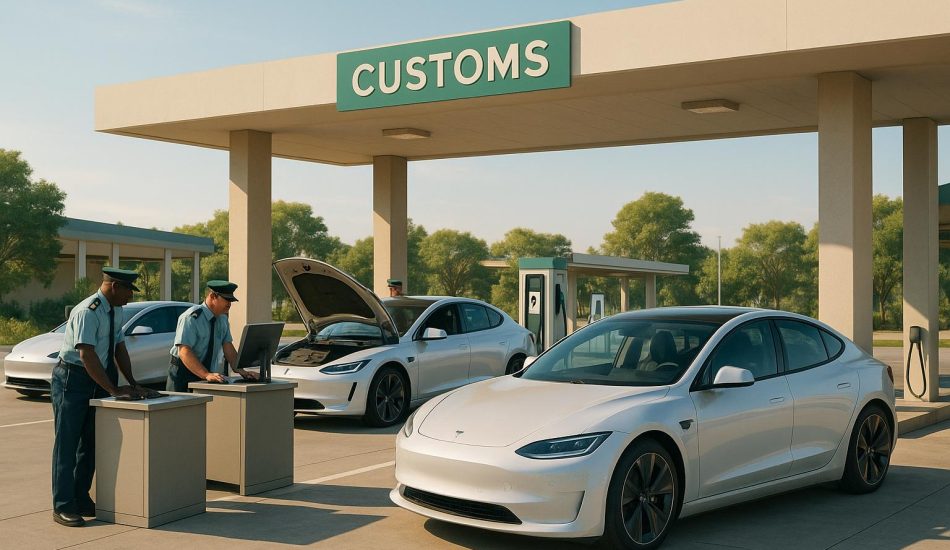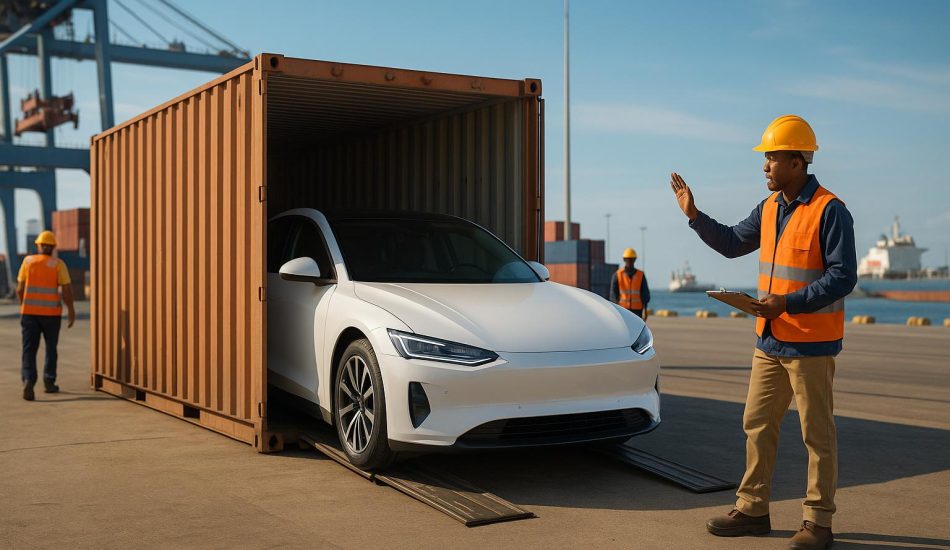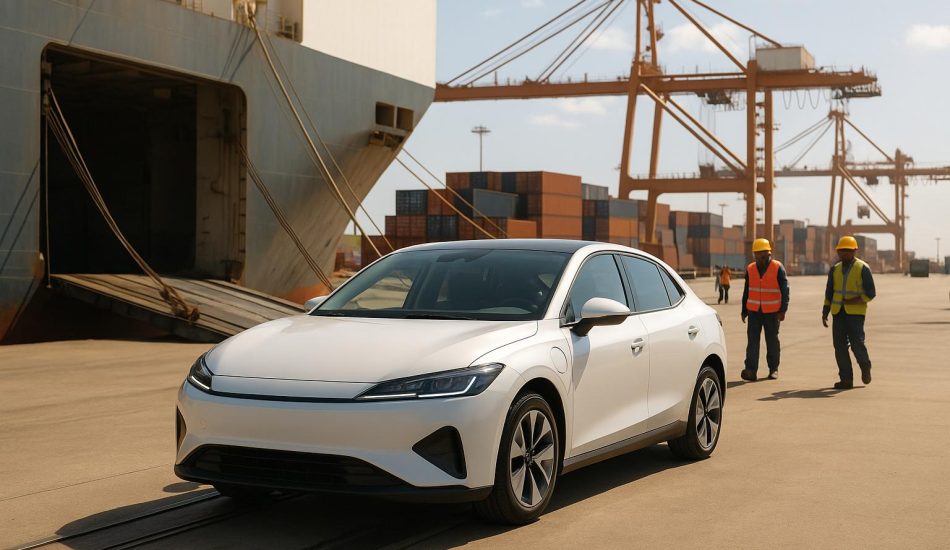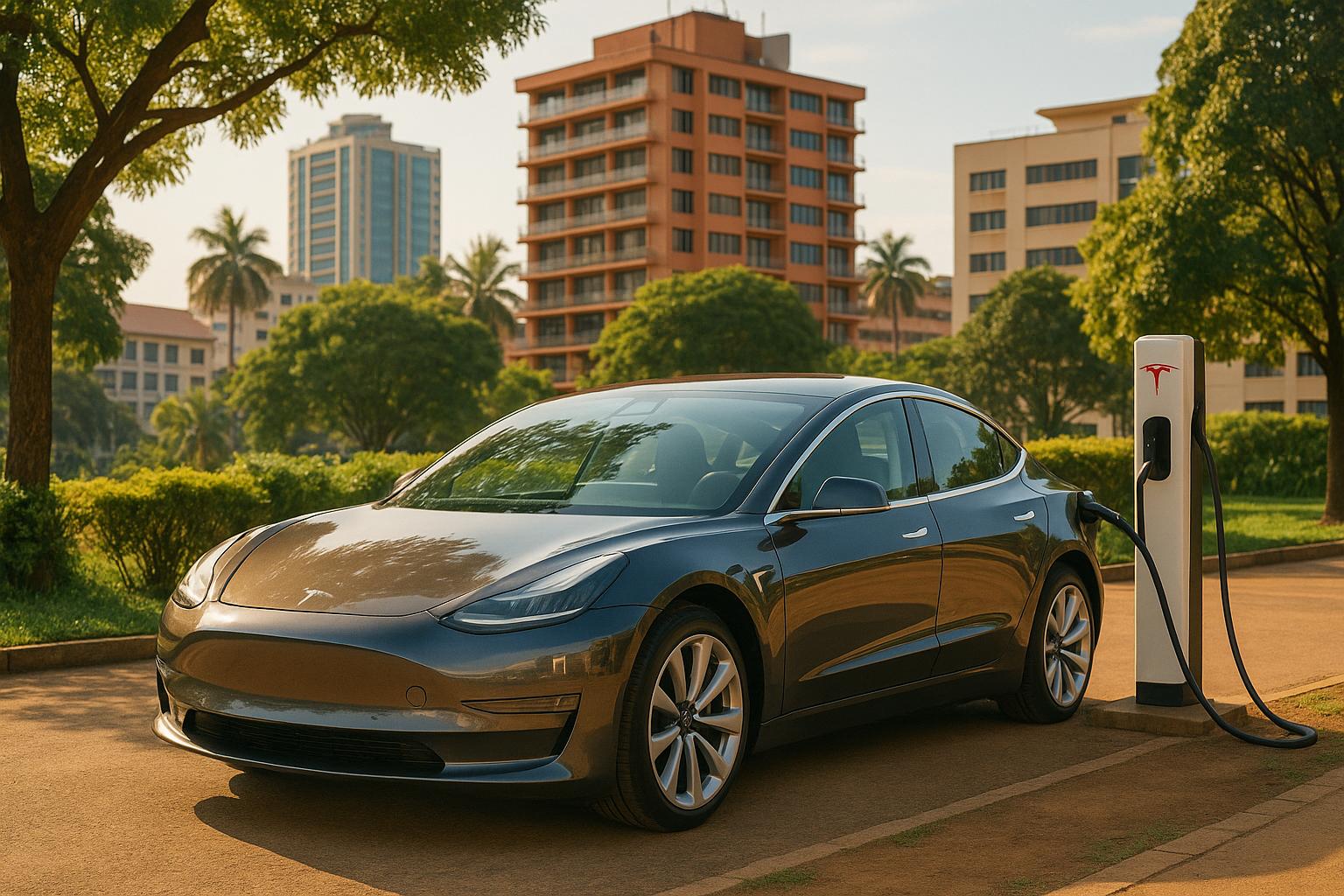
Tesla is gaining traction in Uganda as electric vehicles (EVs) become more appealing to professionals and tech enthusiasts. With four models available – Model 3, Model Y, Model S, and Model X – buyers can choose based on their needs, from compact sedans to full-size SUVs. Prices are influenced by import taxes, currency rates, and dealer markups, while Uganda’s growing charging infrastructure and renewable energy sources support EV adoption. However, limited public charging and high upfront costs remain challenges. Home charging and solar setups are popular solutions, and platforms like EV24.africa simplify purchasing and financing. Teslas promise lower running costs, advanced features, and reduced emissions, but buyers should weigh these benefits against practical limitations like service availability and charging access.
Quick Overview:
- Models Available: Model 3, Model Y, Model S, Model X
- Key Features: Long range, Autopilot, over-the-air updates
- Challenges: Limited charging stations, high import costs
- Opportunities: Home charging, renewable energy compatibility
- Support: EV24.africa for pricing, financing, and delivery
Tesla ownership in Uganda offers exciting potential for early adopters but requires careful planning around infrastructure and costs.
Tesla EV Models Available in Uganda in 2025
Tesla Model Lineup
Tesla is set to introduce four distinct models to Uganda’s market by 2025, catering to a variety of lifestyles and needs. From sleek sedans for city driving to spacious SUVs for larger families, there’s something for everyone in Tesla’s lineup.
The Model 3 is Tesla’s entry-level sedan, designed with urban professionals and daily commuters in mind. Its streamlined four-door design offers a balance of performance and affordability, making it an appealing choice for those looking to step into the world of electric vehicles without breaking the bank.
For those needing a bit more space and versatility, the Model Y is Tesla’s compact SUV. With its higher ground clearance and extra cargo capacity, it’s well-suited to Uganda’s diverse road conditions. Whether you’re navigating city streets or venturing into rural areas, the Model Y combines the efficiency of a sedan with the practicality of an SUV, making it a popular choice for families and frequent travelers.
The Model S serves as Tesla’s flagship sedan, offering a premium experience for those who value luxury and cutting-edge technology. With the longest range in Tesla’s lineup and top-tier performance, the Model S is ideal for executives and tech enthusiasts seeking sophistication and innovation in their vehicle.
Rounding out the lineup is the Model X, Tesla’s full-size SUV. Known for its striking falcon-wing doors and spacious three-row seating, the Model X is perfect for families or anyone needing maximum passenger and cargo space. Its combination of style, utility, and advanced features makes it a standout option.
All Tesla models come equipped with standard features like a large touchscreen interface, over-the-air software updates, and varying levels of Autopilot functionality. However, the availability of specific trims and configurations in Uganda will depend on local importers and dealerships, with the Model 3 and Model Y likely to be the most widely available due to their popularity.
Tesla Model Comparison
Here’s a quick breakdown of the key specifications and features of each Tesla model, helping Ugandan buyers make informed decisions based on their needs and budget.
| Model | Body Style | Range | Battery Size | Seating | Drivetrain Options |
|---|---|---|---|---|---|
| Model 3 | Compact Sedan | 272-358 miles | 57.5-82 kWh | 5 passengers | RWD, AWD |
| Model Y | Compact SUV | 244-330 miles | 57.5-82 kWh | 5-7 passengers | RWD, AWD |
| Model S | Full-size Sedan | 405-516 miles | 100 kWh | 5 passengers | AWD |
| Model X | Full-size SUV | 348-516 miles | 100 kWh | 6-7 passengers | AWD |
Range is a critical factor for Ugandan buyers, especially given the limited charging infrastructure outside major cities. The Model S and Model X, with their extended ranges, are better suited for long journeys between cities like Kampala, Jinja, or Mbarara, minimizing the need for frequent charging stops.
Battery size also plays a role in both range and charging times. While the Model S and Model X boast larger 100 kWh batteries for extended range, they take longer to charge. On the other hand, the smaller batteries in the Model 3 and Model Y charge faster but require more frequent recharging sessions.
Seating capacity is another important consideration, particularly for larger households. The Model Y offers an optional third row, making it a flexible choice for families, while the Model X comes standard with three-row seating and convenient access through its falcon-wing doors.
Drivetrain options cater to different driving needs. Rear-wheel drive (RWD) models are more affordable and sufficient for most conditions, while all-wheel drive (AWD) versions provide enhanced traction during Uganda’s rainy seasons and better performance on challenging roads.
Lastly, ground clearance is a key feature for navigating Uganda’s less-maintained roads. The Model Y and Model X, with their higher clearance, handle unpaved and rough roads more effectively, while the Model 3 and Model S are better suited for smoother urban and highway surfaces.
Tesla Car Prices in Uganda: Current and Projected (2025)
Current Tesla Model Prices
With Tesla’s growing presence worldwide, understanding their pricing in Uganda is essential for potential buyers. Tesla vehicles in Uganda come with added costs due to importation, including shipping fees, taxes, and duties. These factors, along with the specific model, trim, battery setup, and optional features, determine the final price. While some models offer a relatively lower entry point, others – equipped with extended range or high-performance features – carry a premium price tag. Below are the primary factors influencing the cost of Tesla cars in Uganda.
What Affects Tesla Prices in Uganda
Several elements contribute to the final price of Tesla vehicles in Uganda:
- Import duties and taxes: Uganda imposes significant duties and taxes on imported vehicles, which can sharply increase the price beyond the manufacturer’s base cost.
- Currency exchange rates: The value of the Ugandan shilling against the US dollar plays a major role in price fluctuations.
- Shipping and logistics: Expenses for ocean freight, port handling, and transportation within Uganda add to the overall cost.
- Dealer markups and optional features: Importers or dealers may apply markups, and buyers opting for advanced battery technology, performance upgrades, or luxury interiors will face additional charges.
Expected Price Changes for 2025
Looking ahead to 2025, Tesla prices in Uganda are likely to be shaped by a mix of market trends and government policies. If manufacturing processes become more efficient or Uganda introduces EV-friendly policies like reduced import duties or tax incentives, prices could stabilize or even decrease slightly. However, the growing global demand for electric vehicles might counterbalance these potential savings. Ultimately, buyers should expect some level of price variation, driven by both economic factors and regulatory changes.
Tesla Specifications and Road Suitability for Uganda
Tesla Model Technical Specs
Tesla vehicles are known for their powerful battery systems, quick acceleration, and a suite of smart features. Standard offerings include Autopilot, adaptive cruise control, automatic emergency braking, lane-keeping assistance, and over-the-air software updates. These cars are also equipped with tried-and-tested safety systems. Such features make Teslas well-suited for navigating the diverse road conditions found in Uganda.
How Tesla Models Handle Uganda’s Roads and Climate
Tesla’s advanced technology is designed to handle a variety of conditions, which is particularly useful in Uganda, where roads range from modern highways to rugged rural tracks. Some Tesla models come with adaptive suspension systems that can adjust ride height, making them more capable on uneven terrain. Uganda’s moderate climate is another plus, as it reduces the strain on Tesla’s battery systems compared to harsher environments. Additionally, features like water resistance and traction control ensure safer driving during the rainy season. These capabilities allow Teslas to perform reliably on both urban streets and more challenging rural routes.
However, there’s a significant limitation – Uganda’s charging infrastructure is still in its early stages. Many Tesla owners must rely on home charging setups, which can limit the feasibility of long-distance travel, especially outside major cities.
Tesla EV Advantages and Disadvantages in Uganda
Tesla vehicles bring a mix of benefits and challenges for drivers in Uganda. Here’s a closer look:
| Advantages | Disadvantages |
|---|---|
| Lower running costs compared to gas-powered vehicles | Limited public charging options outside urban areas |
| Less maintenance due to the absence of an internal combustion engine | High upfront costs, driven by import taxes and duties |
| Exceptional performance combined with cutting-edge technology | Few official Tesla service centers and limited local support |
| Zero tailpipe emissions, making them eco-friendly | Uncertain resale value in a developing EV market |
| Regular improvements via over-the-air updates | Occasional difficulties sourcing spare parts, often requiring international orders |
Tesla’s regenerative braking system is another noteworthy feature. It captures energy during deceleration, improving efficiency – especially useful on Uganda’s hilly and varied terrain.
While Tesla vehicles offer an impressive mix of innovation, performance, and environmental benefits, potential buyers in Uganda should weigh these advantages against practical considerations like the availability of charging infrastructure and service support.
Tesla Ownership in Uganda: Charging, Costs, and Maintenance
EV Charging Options in Uganda
For Tesla owners in Uganda, home charging is the go-to option, as the country’s charging infrastructure is still in its early stages. Public charging stations are mostly found in urban hubs like Kampala and Entebbe, leaving rural areas with limited access. Many owners opt for Level 2 home chargers, which allow for convenient overnight charging. Thanks to Uganda’s plentiful sunshine, some Tesla drivers are turning to solar charging systems to reduce reliance on the grid while embracing renewable energy. These charging methods highlight both the opportunities and challenges of owning a Tesla in Uganda.
Tesla Financing and Purchase Options
Purchasing a Tesla in Uganda often requires a large upfront payment, as cash remains the most common method. However, some local banks are beginning to introduce financing options tailored to electric vehicles. Platforms like EV24.africa help streamline the buying process by offering clear pricing, detailed vehicle descriptions, and connections to verified sellers across Africa. They also assist buyers with import logistics and financing, making it easier to navigate the complexities of owning an EV in Uganda.
Tesla Maintenance, Service, and Warranty
Once the vehicle is purchased, ongoing maintenance and service become key aspects of ownership. Teslas require less routine maintenance compared to traditional gasoline cars, as there’s no need for oil changes or spark plug replacements. In Uganda, regular upkeep usually involves tire rotations, brake inspections, and replacing filters. However, the lack of official Tesla service centers in the country presents unique challenges. Many owners rely on skilled independent mechanics or travel to nearby regions for more complex repairs. Ordering replacement parts often involves international shipping, which can lead to delays and additional costs. For major repairs, like battery replacements, planning ahead is essential to avoid unexpected disruptions. These factors make maintenance a critical part of the Tesla ownership experience in Uganda.
sbb-itb-99e19e3
Tesla Market Trends and 2025 Outlook for Uganda
Tesla’s Market Growth Potential in Uganda
Uganda’s electric vehicle (EV) market is showing steady progress, with approximately 3,000 EVs already on the roads. While this number may seem small, it lays the groundwork for Tesla to expand its presence. Uganda’s young and increasingly urban population creates favorable conditions for EV adoption. Younger consumers are generally more inclined to embrace new technology, and urban areas often provide better infrastructure to support EVs.
An important factor working in Uganda’s favor is its energy landscape. About 90% of the country’s energy comes from renewable sources, giving Tesla owners the chance to fully embrace clean transportation while moving away from fossil fuels. This renewable energy foundation not only enhances the environmental appeal of EVs but also aligns perfectly with Tesla’s mission to promote sustainability.
The Ugandan government is also playing a key role in driving EV adoption. The launch of the first public EV charging station in Kampala marks a major step forward for the industry. Additionally, lawmakers are working on a regulatory framework to establish licensing and set standards for EV charging infrastructure. On the production side, Uganda’s automotive sector has the capacity to manufacture up to 10,000 EVs annually, with 40% of components sourced locally. This commitment to local production could enhance the availability of parts and services, making EV ownership more accessible. These developments pave the way for platforms that simplify the buying process and encourage further adoption.
How EV24.africa Supports Uganda’s EV Market
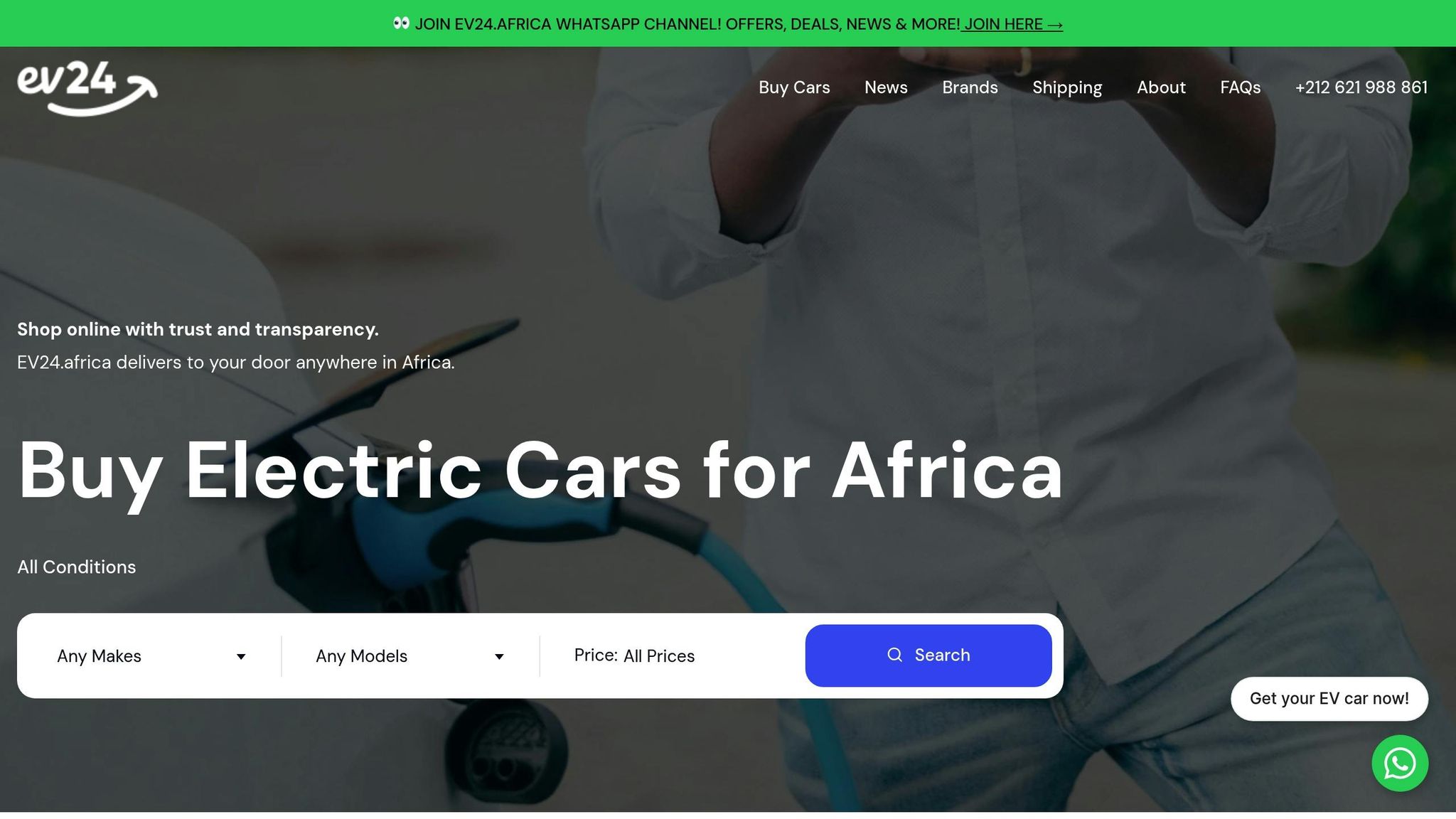
EV24.africa is making Tesla ownership in Uganda easier by tackling common barriers to EV adoption. One of its standout features is transparent Tesla pricing, which breaks down the full cost of ownership. This is particularly helpful in emerging markets like Uganda, where pricing clarity can often be a challenge.
The platform also simplifies the logistics of vehicle delivery across 54 African countries, including Uganda. Buyers can browse Tesla listings, compare features, and arrange delivery without having to navigate the complexities of international shipping. This accessibility extends Tesla’s reach beyond major urban areas.
In addition, EV24.africa connects buyers with financing options specifically designed for EVs. It also provides detailed vehicle specifications and expert advice, which is especially valuable for first-time EV buyers as local expertise in Tesla vehicles continues to grow.
Tesla Market Opportunities and Challenges Ahead
While several trends support Tesla’s growth in Uganda, the journey is not without obstacles. One significant advantage for Uganda and other African nations is the ability to leapfrog traditional fossil fuel infrastructure. Without being tied to outdated systems, Uganda can build EV-friendly networks from scratch, potentially accelerating Tesla adoption faster than in regions with entrenched gasoline-based infrastructure.
However, there are notable hurdles that could slow down progress. Limited charging infrastructure and grid capacity make long-distance travel challenging, even with Uganda’s renewable energy resources. Upgrading the grid will be essential to support Tesla’s high-power charging needs.
Another major challenge is the high cost of EV technology, which places Tesla vehicles beyond the reach of many Ugandan consumers. Without tax incentives or subsidies, Tesla’s premium pricing limits its accessibility to a broader audience.
Despite these challenges, Uganda’s EV market shows strong potential. With its renewable energy resources, government support, and growing consumer interest, the stage is set for Tesla to make significant strides. As charging networks expand and costs potentially come down, Tesla’s position in Uganda’s market could grow stronger by 2025. Overcoming these challenges will be key to cementing Tesla’s role in Uganda’s transition to electric mobility.
Making the Switch to Tesla EVs in Uganda
Key Points for Ugandan Tesla Buyers
Switching to a Tesla in Uganda involves looking at several important factors. Electric vehicles (EVs) provide a chance to cut down on emissions, which appeals to drivers who are focused on cleaner, greener transportation options.
Since Uganda’s charging infrastructure is still growing, it’s crucial to plan your routes around existing charging stations and consider installing a home charger. Tesla ownership tends to be more practical for urban drivers, as rural areas often lack sufficient charging facilities.
While the initial cost of a Tesla may seem steep, it’s worth comparing this to the savings on fuel, lower maintenance costs, and the long-term perks of owning an EV. Tesla’s frequent software updates mean your car can improve over time, adding even more value.
The growing interest in EVs in Uganda offers early adopters a chance to be part of a forward-looking community and help drive the shift to cleaner transportation. Staying updated on developments in local infrastructure and policies can make the transition even smoother.
These factors can help ensure a successful and rewarding move to Tesla ownership.
Next Steps for Tesla Buyers
Once you’ve considered these key points, here’s how to take the next steps toward owning a Tesla. Start by exploring Tesla models and pricing on EV24.africa. This platform provides clear pricing, detailed specs, and access to financing options tailored for EV buyers in African markets.
EV24.africa also handles delivery logistics, simplifying the process of shipping a Tesla to Uganda or other countries in the region. You can compare different models, review their features, and get expert advice to guide your decision.
Before committing, take time to evaluate your driving habits and charging options. Think about your daily commute, the possibility of setting up a home charger, and how close you are to public charging stations. Consulting a local electrician can help you understand the costs and requirements of home charging installations.
Joining Uganda’s growing EV community can also be incredibly helpful. Current Tesla owners can share their experiences with service, parts availability, and maintenance, giving you a clearer picture of what to expect. Learning from their insights will prepare you for a smoother ownership experience in Uganda.
WHAT WOULD IT COST TO OWN AN ELECTRIC CAR IN UGANDA? IS IT WORTH IT? AFRICARSUG
FAQs
What challenges do Tesla owners face with charging in Uganda, and what solutions are available?
Tesla owners in Uganda encounter a range of hurdles when it comes to charging their vehicles. The most pressing issues include a scarce charging infrastructure, an unstable power supply, and the steep expenses involved in setting up charging stations. These factors combine to create significant difficulties for EV owners seeking convenient and affordable charging options.
To tackle these problems, various solutions are being considered. These include expanding the network of charging stations, implementing solar-powered, off-grid charging systems, and leveraging renewable energy sources to provide a more stable power supply. The goal of these initiatives is to make charging easier, more dependable, and budget-friendly for Tesla owners in the region.
How does importing a Tesla impact its price in Uganda, and will there be changes by 2025?
Importing a Tesla into Uganda comes with a hefty price tag due to multiple taxes, duties, and fees. Currently, the breakdown includes an import duty of 15%, a 17% VAT, a 2% commission, and a 6% withholding tax on the dutiable value. Together, these charges significantly inflate the vehicle’s original cost.
Looking ahead to 2025, these rates are expected to hold steady unless Uganda revises its tax or tariff policies. However, any changes to import regulations could alter the final cost, so staying informed about policy updates is crucial if you’re considering such a purchase.
What should Ugandan Tesla owners know about maintenance and service options?
Tesla vehicles are built with simplicity in mind, eliminating the need for oil changes or emissions checks. In Uganda, Tesla Services Limited in Kampala provides authorized servicing, while mobile technicians can address many repairs right at your location. This approach minimizes the need for frequent trips to a service center.
Since service centers are limited in Uganda, it’s worth paying attention to how close you are to an authorized location and the availability of mobile services. Regular software updates also play a big role in keeping your Tesla running smoothly, often without requiring a visit to a service center.


